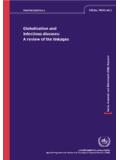Transcription of EVIDENCE FOR ACTION TECHNICAL PAPERS EFFECTIVENESS …
1 EVIDENCE FOR ACTION TECHNICAL PAPERS . EFFECTIVENESS OF STERILE NEEDLE. AND SYRINGE PROGRAMMING. IN REDUCING HIV/ aids AMONG. INJECTING DRUG USERS. World Health Organization WHO Library Cataloguing-in-Publication Data EFFECTIVENESS of sterile needle and syringe programming in reducing HIV/ aids . among injecting drug users. ( EVIDENCE for ACTION TECHNICAL PAPERS ). infections - prevention and control. immunodeficiency syndrome - prevention and control - supply and distribution - supply and distribution programs literature medicine Health Organization. ISBN 92 4 159164 1 (NLM classification: WC ).
2 World Health Organization 2004. All rights reserved. Publications of the World Health Organization can be obtained from Marketing and Dissemination, World Health Organization, 20 Avenue Appia, 1211 Geneva 27, Switzerland (tel: +41 22 791 2476; fax: +41 22 791 4857; email: Requests for permission to reproduce or translate WHO. publications whether for sale or for noncommercial distribution should be addressed to Marketing and Dissemination, at the above address (fax: +41 22. 791 4806; email: The designations employed and the presentation of the material in this publica- tion do not imply the expression of any opinion whatsoever on the part of the World Health Organization concerning the legal status of any country, territory, city or area or of its authorities, or concerning the delimitation of its frontiers or boundaries.))
3 Dotted lines on maps represent approximate border lines for which there may not yet be full agreement. The mention of specific companies or of certain manufacturers' products does not imply that they are endorsed or recommended by the World Health Organization in preference to others of a similar nature that are not mentioned. Errors and omissions excepted, the names of proprietary products are distin- guished by initial capital letters. All reasonable precautions have been taken by WHO to verify the information contained in this publication. However, the published material is being distributed without warranty of any kind, either express or implied.
4 The responsibility for the interpretation and use of the material lies with the reader. In no event shall the World Health Organization be liable for damages arising from its use. Printed in Switzerland EVIDENCE FOR ACTION TECHNICAL PAPERS . EFFECTIVENESS OF STERILE NEEDLE. AND SYRINGE PROGRAMMING. IN REDUCING HIV/ aids AMONG. INJECTING DRUG USERS. World Health Organization Geneva 2004. ACKNOWLEDGEMENTS. This review was authored by Dr. Alex Wodak and Ms Annie Cooney. A large international network of researchers and colleagues have made important contributions to the development of this publication.
5 These researchers and colleagues include: Francisco Bastos, Anindya Chatterjee, Nick Crofts, Don Des Jarlias, Kate Dolan, Catherine Hankins, Ed Kaplan, Richard Needle, Swarup Sarkar, Gerry Stimson, Steffanie Strathdee, Don Sutherland, and Owen Westcott. We also acknowledge the many individuals from many countries around the world who have attempted to fund and encourage research in this area, assist the difficult process of translating research findings into policy, operate services despite funding inadequacy and work with injecting drug users and communities. Andrew Ball, Monica Beg, Manuela Moeller, Richard Steen and Gundo Weiler from WHO edited the publication, which was developed under the supervision of Isabelle de Zoysa, Director of Prevention, Department of HIV/ aids , WHO.
6 WHO acknowledges the generous contribution of the Australian Agency for International Development (AusAID) to the development of this publication. 1 EFFECTIVENESS OF STERILE NEEDLE AND SYRINGE PROGRAMMING. CONTENTS. Preface ..4. 1. Introduction ..5. Terms of reference ..6. 2. Methodology ..7. 3. Results ..9. The EFFECTIVENESS of bleach and decontamination strategies ..9. Strength of association HIV ..9. Replication of findings ..9. Specificity of association ..9. Temporal sequence ..9. Biological plausibility ..9. Biological gradient ..10. Coherence of the EVIDENCE ..10.
7 Experimental EVIDENCE ..10. Reasoning by analogy ..10. Cost EFFECTIVENESS ..10. Absence of negative consequences ..10. Feasibility of implementation, expansion and coverage ..10. Unanticipated benefits ..11. Special populations ..11. The EFFECTIVENESS of needle syringe programmes ..11. Strength of association ..11. Replication of findings ..12. Specificity of association ..12. Temporal sequence ..12. Biological plausibility ..13. Biological gradient ..14. Coherence of the EVIDENCE ..14. Experimental EVIDENCE ..14. Reasoning by analogy ..15. Cost- EFFECTIVENESS ..15. Absence of negative consequences.
8 16. Feasibility of implementation, expansion and coverage ..16. Unanticipated benefits ..17. Special populations ..17. The EFFECTIVENESS of the sale of needles and syringes from pharmacies and vending machines in preventing HIV infection among injecting drug user ..18. Strength of association ..18. Replication of findings ..19. Specificity ..19. Temporal sequence ..19. Biological plausibility ..20. Biological gradient ..20. WHO DEPARTMENT OF HIV/ aids 2. Coherence of the EVIDENCE ..20. Experimental EVIDENCE ..20. Reasoning by analogy ..20. Cost EFFECTIVENESS ..20. Absence of negative consequences.
9 21. Feasibility of implementation, expansion and coverage ..21. Unanticipated benefits ..21. Special populations ..21. EVIDENCE for needle syringe disposal ..22. Summary of PAPERS of disposal of needles and syringes ..22. Injecting paraphernalia legislation ..22. Strength of association ..22. Replication of results ..22. Specificity ..23. Temporal sequence ..23. Biological plausibility ..24. Biological gradient ..24. Coherence ..24. Experimental EVIDENCE ..24. Reasoning by analogy ..24. Cost EFFECTIVENESS ..24. Absence of negative consequences ..25. Feasibility of implementation, expansion and coverage.
10 25. Unanticipated benefits ..25. Special populations ..25. 4. Discussion ..26. 5. Conclusions ..28. There is compelling EVIDENCE that increasing the availability and utilization of sterile injecting equipment by IDUs reduces HIV infection substantially ..28. There is no convincing EVIDENCE of any major, unintended negative consequences ..28. Needle syringe programmes are cost-effective ..28. Needle syringe programmes have additional and worth while benefits apart from reducing HIV infection among IDUs ..28. Bleach and other forms of disinfection are not supported by good EVIDENCE of EFFECTIVENESS for reducing HIV infection.













